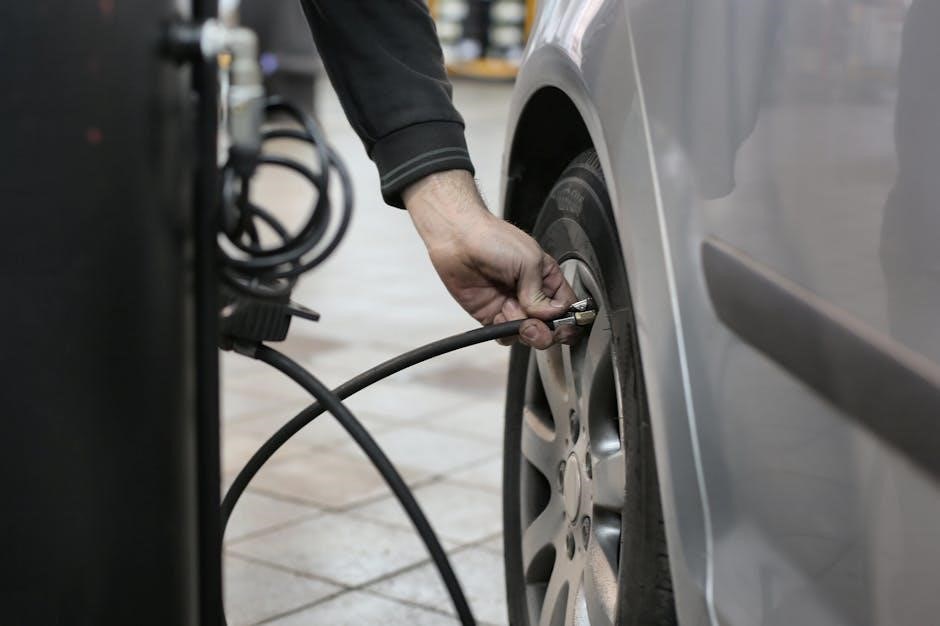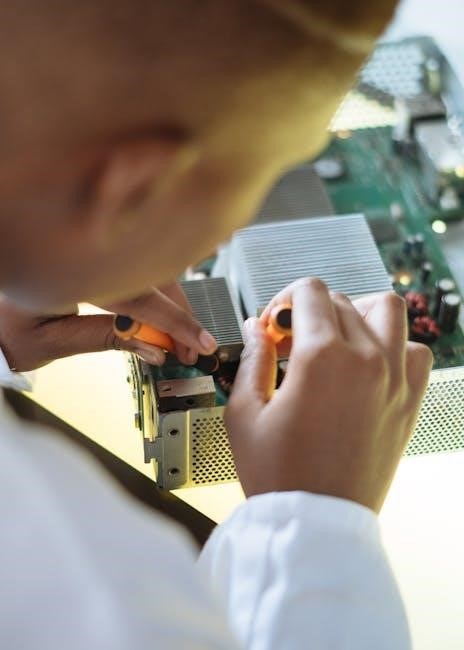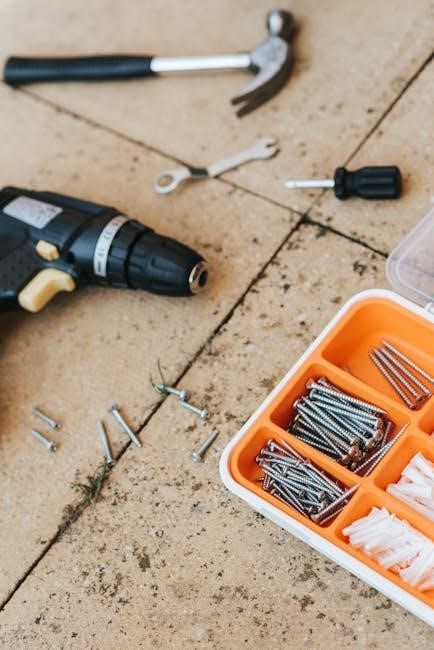
This Gogo scooter repair manual serves as an invaluable resource for owners‚ offering comprehensive guidance on maintenance‚ troubleshooting‚ and repairs. Designed for both new and experienced users‚ it ensures safety‚ optimal performance‚ and longevity of your scooter through detailed instructions and expert tips.
Overview of Gogo Scooter Models
The Gogo scooter lineup includes several models designed for convenience‚ portability‚ and reliability. The Gogo Classic is the base model‚ offering a balance of affordability and essential features. The Gogo Pro and Gogo Elite models are upgraded versions‚ featuring enhanced performance‚ longer range‚ and advanced features like improved braking systems and customizable settings. Additionally‚ the Gogo Lite is a compact‚ lightweight option ideal for short-distance commutes. Each model is built with a durable frame‚ reliable motor‚ and user-friendly controls‚ catering to different rider preferences and needs. Understanding the specific model you own is crucial for proper maintenance and repair‚ as slight variations in design and components may exist across the lineup. This manual is designed to be adaptable to all Gogo scooter models‚ ensuring comprehensive coverage for users.
Importance of a Repair Manual
A repair manual is an essential resource for Gogo scooter owners‚ providing detailed guidance for maintenance‚ troubleshooting‚ and repairs. It empowers users to address issues independently‚ saving time and money by avoiding costly visits to service centers. The manual offers step-by-step instructions‚ ensuring that repairs are done safely and correctly‚ which is critical for maintaining the scooter’s performance and longevity. Additionally‚ it helps users understand how their scooter operates‚ fostering a deeper connection to the vehicle and enabling proactive care. By following the manual‚ riders can prevent minor issues from escalating into major problems‚ ensuring their scooter remains reliable and safe to use. This guide is tailored to help users maximize their scooter’s potential while minimizing downtime. It serves as a comprehensive toolkit for every Gogo scooter owner seeking to maintain or repair their vehicle effectively.
How to Use This Manual Effectively
To maximize the benefits of this Gogo scooter repair manual‚ start by thoroughly reviewing the table of contents to familiarize yourself with its structure. Use the index to quickly locate specific topics or tasks. Always read the safety guidelines before attempting any repairs to ensure a safe working environment. Gather all necessary tools and materials beforehand‚ as listed in the manual‚ to avoid delays. Follow the step-by-step instructions carefully‚ and refer to diagrams or illustrations for clarity. Pay attention to warnings‚ cautions‚ and notes‚ as they provide critical information to prevent damage or injury. After completing a task‚ test your scooter to ensure proper functionality. Keep the manual handy for future reference‚ and update your knowledge with any supplementary materials provided. By following these steps‚ you can use this manual effectively and maintain your Gogo scooter with confidence. Regular use will enhance your troubleshooting and repair skills.

Safety Guidelines
Always prioritize safety when repairing your Gogo scooter. Wear protective gear‚ ensure the scooter is stable‚ and avoid distractions. Keep loose clothing tied back and ensure the scooter is turned off before starting work.
General Safety Precautions
When performing repairs on your Gogo scooter‚ always prioritize your safety and the integrity of the vehicle. Start by wearing appropriate protective gear‚ including gloves‚ safety glasses‚ and closed-toe shoes. Ensure the scooter is placed on a stable‚ level surface and secured to prevent accidental movement. Avoid working in hazardous environments‚ such as near open flames or in poorly ventilated areas. Never attempt repairs while the scooter is in operation or under power. Disconnect the battery before starting any electrical work to prevent unexpected start-ups. Keep loose clothing and long hair tied back to avoid entanglement with moving parts. Maintain a clean workspace to reduce the risk of accidents. Always follow the manufacturer’s instructions and guidelines for specific tasks. If unsure about a procedure‚ consult a professional or the official Gogo scooter repair manual for guidance.
Essential Tools and Equipment
To efficiently repair and maintain your Gogo scooter‚ it is crucial to have the right tools and equipment. A socket set and spanners or wrenches are essential for tightening and loosening bolts and nuts. Pliers‚ screwdrivers (both flathead and Phillips)‚ and insulated screwdrivers for electrical work are must-haves. Wire cutters and a multimeter are handy for diagnosing and repairing electrical issues. For brake maintenance‚ a brake bleeding kit ensures proper brake function. A tire pressure gauge is necessary for maintaining correct tire pressure. Specialized tools like a torque wrench‚ Allen key set‚ and chain tool (if applicable) are also important. A work stand or lift can make repairs more manageable‚ and a service manual specific to your scooter model is invaluable for guidance. Always ensure your tools are in good condition to guarantee safety and effectiveness during repairs.
Safe Handling of Electrical Components
When working with your Gogo scooter’s electrical system‚ safety is paramount to avoid injuries or damage. Always disconnect the battery before handling any electrical components to prevent shocks or short circuits. Use insulated tools to prevent accidental contact with live wires. Wear protective gloves and goggles to safeguard against electrical arcs or sparks. Ensure the scooter is on level ground and in a well-ventilated area. Never touch electrical components with wet hands or while standing on a wet surface. Avoid exposing sensitive electronics to water or excessive heat. Inspect wires and connectors for damage before reconnecting the battery. If unsure about any procedure‚ consult the manual or seek professional assistance. Proper grounding and isolation of electrical systems are critical to prevent malfunctions and ensure rider safety. Always test components at low power first to identify potential issues before full operation.

Understanding Your Gogo Scooter Components
Familiarize yourself with your scooter’s components to ensure proper maintenance and repair. This section provides detailed insights into key parts‚ helping you identify and address issues effectively.

Key Components Overview
Your Gogo scooter is built with essential components designed for durability and performance. The frame serves as the structural foundation‚ while the motor powers the scooter. The battery provides energy storage‚ and the control system manages speed and braking. The wheels and tires ensure stability‚ and the suspension enhances ride comfort. Electrical components like the motor controller and wiring connect everything. Braking systems‚ including brakes and levers‚ are critical for safety. Additional features such as lights‚ alarms‚ and displays contribute to functionality. Understanding these components helps you perform repairs and maintenance effectively. Always refer to the manual for specific details on your model.
The Frame and Structural Integrity
The frame is the backbone of your Gogo scooter‚ providing structural support and ensuring stability. Made from durable materials like aluminum or steel alloys‚ it is designed to withstand regular use while maintaining lightweight portability. The frame includes the stem‚ handlebar mounting points‚ and the deck where the battery and electrical components are housed. Its structural integrity is critical for safety and performance‚ as it absorbs shocks and distributes weight evenly. Regular inspections are essential to identify any signs of damage‚ such as dents‚ cracks‚ or rust‚ which can compromise the scooter’s stability. If damage is detected‚ repairs or replacements should be addressed promptly to prevent further issues. A weakened frame can lead to failure during operation‚ posing safety risks to the rider. Always prioritize the frame’s condition to ensure reliable performance and rider safety.
Electrical System Components
Your Gogo scooter’s electrical system is a complex network of components that power its operations. The system includes the motor‚ controller‚ battery‚ wiring harness‚ and sensors. The motor converts electrical energy into mechanical energy‚ propelling the scooter forward. The controller acts as the brain‚ regulating power flow between the battery and motor while monitoring speed and acceleration. Sensors‚ such as speed and temperature sensors‚ provide critical data to the controller to optimize performance and safety. The wiring harness connects all components securely‚ ensuring reliable communication and power distribution. Proper maintenance of these components is vital to prevent electrical failures. Regularly inspect wires for damage‚ clean connections‚ and ensure all sensors are functioning correctly. Faulty electrical components can lead to performance issues or safety hazards‚ so addressing problems promptly is essential for smooth operation. Always refer to the manual for guidance on handling electrical parts safely.
Battery and Charging System
The battery and charging system are critical components of your Gogo scooter‚ providing the power needed for operation. Most models use a high-capacity lithium-ion battery‚ designed for long-range performance and durability. The charging system includes the charger‚ charging port‚ and associated circuitry. Always use the original charger provided with your scooter to ensure compatibility and safety. Overcharging can damage the battery‚ so monitor the charging time closely. The battery management system (BMS) regulates voltage and temperature to prevent overcharging or discharging. Proper storage is essential: keep the battery in a cool‚ dry place and avoid draining it completely. If the scooter is unused for extended periods‚ charge the battery to about 50% capacity. Regularly inspect the charging port for dirt or damage‚ as this can disrupt charging. Refer to the manual for specific charging guidelines and troubleshooting common issues like slow charging or battery drain. Proper care ensures optimal performance and longevity.
Braking System and Safety Features
The braking system on your Gogo scooter is designed to ensure safe and reliable stopping power. Most models feature a combination of disc brakes and electronic braking systems (EBS) for enhanced control. The disc brake system includes a rotor‚ caliper‚ and brake pads‚ which work together to slow the scooter. Regular inspection of brake pads and discs is essential to maintain optimal performance. Additionally‚ the scooter is equipped with safety features such as anti-lock braking systems (ABS) or electronic brake force distribution (EBD) to prevent skidding and improve stability. Always test the brakes before riding to ensure proper function. The scooter may also include features like emergency brakes and regenerative braking‚ which recover energy to extend battery life. Proper maintenance of these systems is critical for rider safety and compliance with local regulations. Refer to the manual for specific guidelines on brake inspections and replacements. Ensure all safety features are fully functional before operation. Regularly clean and lubricate brake components to avoid wear and tear. Always follow safety protocols when adjusting or repairing the braking system. Proper braking performance is vital for a safe and enjoyable riding experience.

Maintenance Tips
Regularly inspect tire pressure‚ brakes‚ and battery. Clean and lubricate moving parts. Schedule routine checks to prevent wear and tear. Refer to the manual for detailed schedules and procedures to ensure optimal performance and longevity of your Gogo scooter.
Routine Maintenance Tasks
Performing routine maintenance is essential to ensure your Gogo scooter operates efficiently and safely. Start by checking the tire pressure and ensuring it matches the recommended levels. Inspect the brakes for wear and tear‚ and test their responsiveness. Clean the scooter regularly‚ paying attention to electrical components and moving parts. Lubricate the folding mechanism‚ throttle‚ and brake levers to maintain smooth operation. Check the battery charge level and ensure it is stored properly when not in use. Inspect the frame for any signs of damage or rust. Test the lights and signals to ensure they are functioning correctly. Finally‚ refer to the manufacturer’s schedule for routine servicing‚ such as replacing worn parts or updating software. Regular maintenance will extend the lifespan of your scooter and prevent unexpected breakdowns.
Battery Care and Charging Tips
Proper care and charging of your Gogo scooter’s battery are crucial for maintaining its performance and longevity. Always use the original charger provided with your scooter to avoid damage. Charge the battery in a cool‚ dry place‚ avoiding extreme temperatures. Do not overcharge‚ as this can reduce the battery’s lifespan. Aim to keep the charge level between 20% and 80% if storing the scooter for an extended period. Avoid letting the battery completely drain to 0%‚ as this can cause irreversible damage. Clean the battery terminals regularly to ensure good connections. If you notice any swelling or leakage‚ stop using the battery immediately and contact a professional. Refer to the manufacturer’s guidelines for specific charging recommendations tailored to your scooter model.
Diagnosing Common Issues
Diagnosing common issues with your Gogo scooter starts with identifying the symptoms. Check for error codes on the display panel‚ as these can provide valuable insights. Common problems include weak acceleration‚ battery drain‚ or braking issues. Begin by inspecting the battery and charging system‚ as these are often the root of performance problems. Ensure the connections are clean and secure. For braking issues‚ inspect the brake pads and cables for wear or damage. If the scooter struggles to start‚ check the power button and electrical connections. Always refer to the troubleshooting section of this manual for model-specific guidance. If the issue persists‚ consult a professional or contact the manufacturer’s support team for assistance. Regular diagnostics can help prevent minor problems from becoming major repairs.

Troubleshooting Common Problems
This section guides you through identifying and resolving common issues with your Gogo scooter‚ such as battery problems‚ error codes‚ or performance issues‚ using step-by-step solutions.
Identifying Symptoms and Causes
Identifying symptoms and causes is the first step in troubleshooting your Gogo scooter. Common issues include a non-responsive display‚ unusual noises‚ or reduced performance. Start by observing the symptoms carefully and noting when they occur. For example‚ if the scooter slows down on inclines‚ it may indicate a battery issue or motor overload. If the display shows an error code‚ refer to the error code list in this manual to understand the problem. Always check for loose connections‚ worn parts‚ or software updates‚ as these are frequent causes of malfunctions. By systematically linking symptoms to potential causes‚ you can narrow down the root of the problem and proceed with the appropriate repair or adjustment. This method ensures efficient troubleshooting and minimizes downtime for your scooter.
Diagnosing Battery-Related Issues
Diagnosing battery-related issues on your Gogo scooter involves identifying common symptoms and pinpointing their causes. If your scooter struggles to start‚ has reduced range‚ or the battery indicator shows unusual behavior‚ it may indicate a battery problem. Start by checking the charging port for dirt or corrosion and ensure the charger is functioning correctly. A faulty charger or loose connections can mimic battery failure. Use a multimeter to test the battery voltage‚ which should match the specifications in your manual. Low voltage or uneven cell balance may signal a failing battery. Additionally‚ overcharging or extreme temperatures can degrade battery health. If issues persist‚ refer to the error codes in this manual for guidance. Addressing battery problems early can prevent further damage and ensure optimal scooter performance. Always prioritize safety when handling electrical components.
Diagnosing Brake Malfunctions
Diagnosing brake malfunctions on your Gogo scooter requires a systematic approach to ensure safety and proper functionality. Start by inspecting the brake pads for wear or contamination. If the pads are worn thin or glazed‚ they may need replacement. Check the brake levers for sponginess‚ which could indicate air in the brake lines or a fluid leak. Test the brake system by gently squeezing the levers and rolling the scooter slowly; if there’s little to no resistance‚ the brakes may not be engaging properly. Use a multimeter to test the brake sensor’s electrical connectivity. Also‚ inspect the brake cables for fraying or damage‚ as this can disrupt braking performance. If the issue persists‚ refer to the troubleshooting guide for specific error codes related to the braking system. Always ensure the scooter is stationary and secure before performing any diagnostics.
Speed and Performance Issues

Diagnosing speed and performance issues on your Gogo scooter involves identifying potential causes such as motor strain‚ throttle malfunctions‚ or controller problems. Start by checking the scooter’s software for updates‚ as outdated firmware can limit performance. Test the throttle by gradually accelerating and decelerating to ensure smooth operation. If the scooter hesitates or stalls‚ inspect the motor for debris or excessive wear. Clean the motor and ensure proper ventilation to prevent overheating. Check the tire pressure‚ as underinflated tires can reduce speed and efficiency. Use a multimeter to verify the voltage output of the battery and ensure it matches the motor’s specifications. If issues persist‚ reset the scooter to factory settings or consult a professional technician for advanced diagnostics. Regular maintenance‚ such as lubricating moving parts and updating software‚ can help maintain optimal performance. Always refer to the user manual for specific troubleshooting steps tailored to your scooter model.
Interpreting Error Codes and Alarms
Understanding error codes and alarms on your Gogo scooter is crucial for timely repairs. Most models display codes like E1‚ E2‚ or E3‚ indicating specific issues such as battery faults‚ motor malfunctions‚ or system errors. Refer to the manual for a detailed list of codes and their meanings. When an alarm sounds‚ check the scooter’s dashboard for flashing lights or digital messages. Common issues include low battery voltage‚ overheating‚ or faulty sensors. Reset the scooter by turning it off and on‚ then test it. If the error persists‚ inspect connections and ensure all components are secure. For complex codes‚ use diagnostic tools or consult a technician. Keep a record of recurring errors for further troubleshooting. Addressing these issues promptly ensures safety and optimal performance. Always follow the manufacturer’s guidelines for resolving error codes to avoid further damage to your scooter.

Repair Guides
This section provides detailed step-by-step instructions for common repairs‚ ensuring your Gogo scooter runs smoothly. Follow these guides to address issues effectively with the right tools and safety precautions.
Replacing the Battery Pack
Replacing the battery pack on your Gogo scooter is a critical task that requires careful attention to detail. Start by ensuring the scooter is turned off and the battery is completely discharged. Wear protective gloves and eyewear for safety. Locate the battery compartment‚ typically under the deck or in the rear section‚ and remove the screws using an Allen wrench. Gently lift the compartment cover and disconnect the battery connectors from the motor controller. Remove the old battery pack and inspect the area for any debris or damage. Install the new battery pack‚ ensuring it is securely fastened and aligned properly. Reconnect the battery connectors‚ making sure they are tight and free from corrosion. Replace the compartment cover and screws‚ then test the scooter to ensure proper function. Always use a compatible battery pack to avoid performance issues or safety risks.
Repairing or Replacing Brake Pads
Repairing or replacing brake pads on your Gogo scooter is essential for maintaining safety and performance. Begin by turning off the scooter and ensuring it is securely supported on a stand or level surface. Wear protective gloves and eyewear. Locate the brake caliper‚ usually near the wheel hub‚ and remove the retaining bolts using an Allen wrench. Gently pull the caliper away from the wheel to access the brake pads. Inspect the pads for wear; if they are thinner than 1mm‚ replacement is necessary. Remove the old pads and install the new ones‚ ensuring proper alignment. Reattach the caliper and tighten the bolts firmly. Test the brakes by squeezing the lever to ensure they engage smoothly and evenly. If you notice any uneven braking or noise‚ adjust the caliper alignment or consult a professional. Regular brake pad maintenance is crucial for rider safety and optimal scooter functionality.

Adjusting the Braking System
Adjusting the braking system on your Gogo scooter ensures optimal stopping power and safety. Start by inspecting the brake lever and pedal for proper alignment and movement. If the lever feels spongy or loose‚ tighten the brake cable by turning the adjusting barrel located near the lever. For the rear brake‚ check the pedal’s tension and adjust the cable accordingly using the barrel adjuster. Next‚ inspect the brake caliper alignment; if misaligned‚ loosen the caliper bolts and realign it with the rotor. Tighten the bolts securely and test the brakes by squeezing the lever or pressing the pedal. Ensure the brakes engage smoothly without dragging or uneven pressure. If issues persist‚ consult the scooter’s manual or a professional mechanic. Proper adjustment ensures reliable braking performance and rider safety.

Additional Resources
Additional resources for your Gogo scooter repair include:
- Official Gogo scooter manuals
- Manufacturer’s website for updated guides
- Online forums for rider advice
- YouTube tutorials with step-by-step videos
- Certified mechanics for complex issues
With this manual‚ you now have a comprehensive guide to maintaining and repairing your Gogo scooter. Regular maintenance and proper repair techniques will ensure your scooter runs smoothly and safely. For further assistance‚ explore official Gogo resources‚ manufacturer support‚ or online forums. Stay informed about updates and best practices to keep your scooter in optimal condition. If complex issues arise‚ consult certified professionals. Remember‚ safety and adherence to guidelines are paramount. Happy riding!